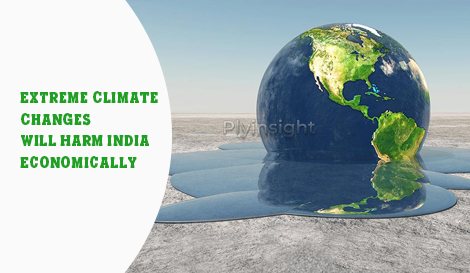
Extreme climate changes will harm India Economically
- अप्रैल 8, 2022
- 0
Referring to India as one of the countries that will be most “economically harmed” by climate change, the report highlights a risky anomaly of it facing both rising sea levels and water scarcity. “India is one of the most vulnerable countries globally in terms of the population that will be affected by sea-level rise. By the middle of the century, around 350 lakh people in India could face annual coastal flooding, with 450-500 lakh at risk by the end of the century,”
The United Nations Intergovernmental Panel on Climate Change (IPCC) presents this grim picture in the second part of its sixth assessment report.
According to the studies cited by the IPCC, climate change and rising demand would lead to at least 40 per cent of the Indian population living with water scarcity by 2050 compared with about 33 per cent now. It is estimated that both the Ganges and Brahmaputra river basins will witness increased flooding as a result of climate change, particularly if warming crosses 1.5 degrees Celsius.
This report conclusively says that the world faces unavoidable multiple climate hazards over the next two decades with global warming of 1.5°C.
The dual impact of rising sea levels and ground water scarcity will have a direct impact on the Indian agriculture sector. One of the chapters in the report says that wheat, pulses, coarse and cereal yields could fall almost 9 per by 2050 in the country. In South India, maize production could decrease 17 per cent if emissions are high. “These disruptions to crop production are expected to cause price spikes in India, threatening food affordability, food security and economic growth.
Urban India is at much greater risk with its increasing share in the country. In the next 15 years, we will see 60 crores people being added to urban spaces,”
During COP26, the climate change conference in Glasgow last year, India had made a case for having an adaptation fund by the developed world to support the climate hazards faced by developing economies like itself. Developed economies, however, committed to no separate loss-and-damage fund, leading to India issuing a note of “deep disappointment”.
“Developed countries must accept the historical responsibility and provide the financial resources to the developing countries,” India had said.
जलवायु परिवर्तन से भारत को आर्थिक नुक्सान
भारत को जलवायु परिवर्तन से सबसे अधिक ‘‘आर्थिक रूप से नुकसान’’ होने वाले देशों में से एक के रूप में संदर्भित करते हुए, रिपोर्ट में समुद्र के बढ़ते स्तर और पानी की कमी दोनों का सामना करने वाली एक जोखिम भरी विसंगति पर प्रकाश डाला गया है। “भारत जनसंख्या के मामले में विश्व स्तर पर सबसे कमजोर देशों में से एक है जो समुद्र के स्तर में वृद्धि से प्रभावित होगा। सदी के मध्य तक, भारत में लगभग 350 लाख लोग वार्षिक तटीय बाढ़ का सामना कर सकते हैं, जिसमें सदी के अंत तक 450-500 लाख जोखिम में हो सकते हैं,”।
जलवायु परिवर्तन पर संयुक्त राष्ट्र अंतर-सरकारी पैनल (आईपीसीसी) द्वारा जारी अपनी छठी आकलन रिपोर्ट के दूसरे भाग में इस गंभीर तस्वीर को प्रस्तुत किया गया है।
आईपीसीसी द्वारा उद्धृत अध्ययनों के अनुसार, जलवायु परिवर्तन और बढ़ती मांग के कारण 2050 तक कम से कम 40 प्रतिशत भारतीय आबादी पानी की कमी से जूझ रही होगी, जबकि अभी यह लगभग 33 प्रतिशत है। यह अनुमान है कि गंगा और ब्रह्मपुत्र दोनों नदीयों में जलवायु परिवर्तन के परिणामस्वरूप बाढ़ में वृद्धि होगी, खासकर अगर वार्मिंग 1.5 डिग्री सेल्सियस को पार कर जाती है।
यह रिपोर्ट निर्णायक रूप से कहती है कि दुनिया अगले दो दशकों में 1.5 डिग्री सेल्सियस की ग्लोबल वार्मिंग के साथ अपरिहार्य कई जलवायु खतरों का सामना करेगी।
समुद्र के बढ़ते स्तर और भूजल की कमी के दोहरे प्रभाव का भारतीय कृषि क्षेत्र पर सीधा प्रभाव पड़ेगा। रिपोर्ट के एक अध्याय में कहा गया है कि देश में 2050 तक गेहूं, दलहन और मोटे अनाज की पैदावार लगभग 9 प्रति गिर सकती है। दक्षिण भारत में, यदि उत्सर्जन अधिक होता है तो मक्का उत्पादन में 17 प्रतिशत की कमी आ सकती है। “फसल उत्पादन में इन व्यवधानों से भारत में कीमतों में वृद्धि, खाद्य सामर्थ्य, खाद्य सुरक्षा और आर्थिक विकास के लिए खतरा पैदा होने की उम्मीद है।
शहरी भारत देश में अपनी बढ़ती हिस्सेदारी के साथ बहुत अधिक जोखिम में है। अगले 15 वर्षों में, हम देखेंगे कि 60 करोड़ लोग शहरी क्षेत्रों में बढ़ जाएंगे,’’।
पिछले साल ग्लासगो में जलवायु परिवर्तन सम्मेलन, COP26 के दौरान, भारत ने अपने जैसे विकासशील अर्थव्यवस्थाओं द्वारा सामना किए जाने वाले जलवायु खतरों का समर्थन करने के लिए विकसित दुनिया द्वारा एक अनुकूलन निधि रखने का मामला उठाया था। विकसित अर्थव्यवस्थाएं, हालांकि, कोई अलग हानि-और-क्षति निधि के लिए प्रतिबद्ध नहीं हैं, जिसके कारण भारत ने ’गहरी निराशा’ का एक नोट जारी किया था।
भारत ने कहा था, ‘‘विकसित देशों को ऐतिहासिक जिम्मेदारी स्वीकार करनी चाहिए और विकासशील देशों को वित्तीय संसाधन उपलब्ध कराने चाहिए।’’
































































